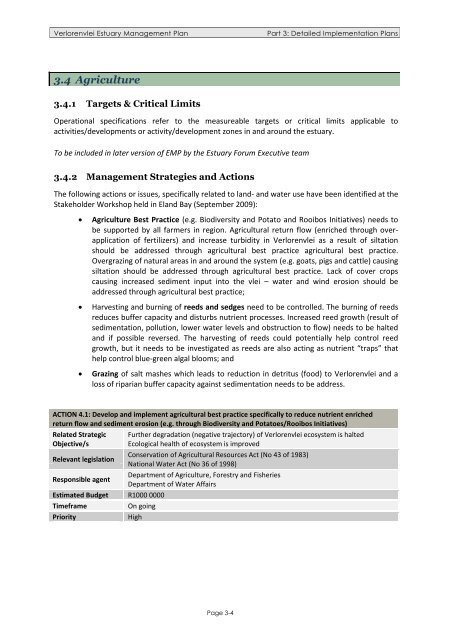Download PDF - Anchor Environmental
Download PDF - Anchor Environmental
Download PDF - Anchor Environmental
You also want an ePaper? Increase the reach of your titles
YUMPU automatically turns print PDFs into web optimized ePapers that Google loves.
Verlorenvlei Estuary Management Plan<br />
Part 3: Detailed Implementation Plans<br />
3.4 Agriculture<br />
3.4.1 Targets & Critical Limits<br />
Operational specifications refer to the measureable targets or critical limits applicable to<br />
activities/developments or activity/development zones in and around the estuary.<br />
To be included in later version of EMP by the Estuary Forum Executive team<br />
3.4.2 Management Strategies and Actions<br />
The following actions or issues, specifically related to land- and water use have been identified at the<br />
Stakeholder Workshop held in Eland Bay (September 2009):<br />
<br />
<br />
<br />
Agriculture Best Practice (e.g. Biodiversity and Potato and Rooibos Initiatives) needs to<br />
be supported by all farmers in region. Agricultural return flow (enriched through overapplication<br />
of fertilizers) and increase turbidity in Verlorenvlei as a result of siltation<br />
should be addressed through agricultural best practice agricultural best practice.<br />
Overgrazing of natural areas in and around the system (e.g. goats, pigs and cattle) causing<br />
siltation should be addressed through agricultural best practice. Lack of cover crops<br />
causing increased sediment input into the vlei – water and wind erosion should be<br />
addressed through agricultural best practice;<br />
Harvesting and burning of reeds and sedges need to be controlled. The burning of reeds<br />
reduces buffer capacity and disturbs nutrient processes. Increased reed growth (result of<br />
sedimentation, pollution, lower water levels and obstruction to flow) needs to be halted<br />
and if possible reversed. The harvesting of reeds could potentially help control reed<br />
growth, but it needs to be investigated as reeds are also acting as nutrient “traps” that<br />
help control blue-green algal blooms; and<br />
Grazing of salt mashes which leads to reduction in detritus (food) to Verlorenvlei and a<br />
loss of riparian buffer capacity against sedimentation needs to be address.<br />
ACTION 4.1: Develop and implement agricultural best practice specifically to reduce nutrient enriched<br />
return flow and sediment erosion (e.g. through Biodiversity and Potatoes/Rooibos Initiatives)<br />
Related Strategic<br />
Objective/s<br />
Relevant legislation<br />
Responsible agent<br />
Estimated Budget R1000 0000<br />
Timeframe<br />
On going<br />
Priority<br />
High<br />
Further degradation (negative trajectory) of Verlorenvlei ecosystem is halted<br />
Ecological health of ecosystem is improved<br />
Conservation of Agricultural Resources Act (No 43 of 1983)<br />
National Water Act (No 36 of 1998)<br />
Department of Agriculture, Forestry and Fisheries<br />
Department of Water Affairs<br />
Page 3-4
















